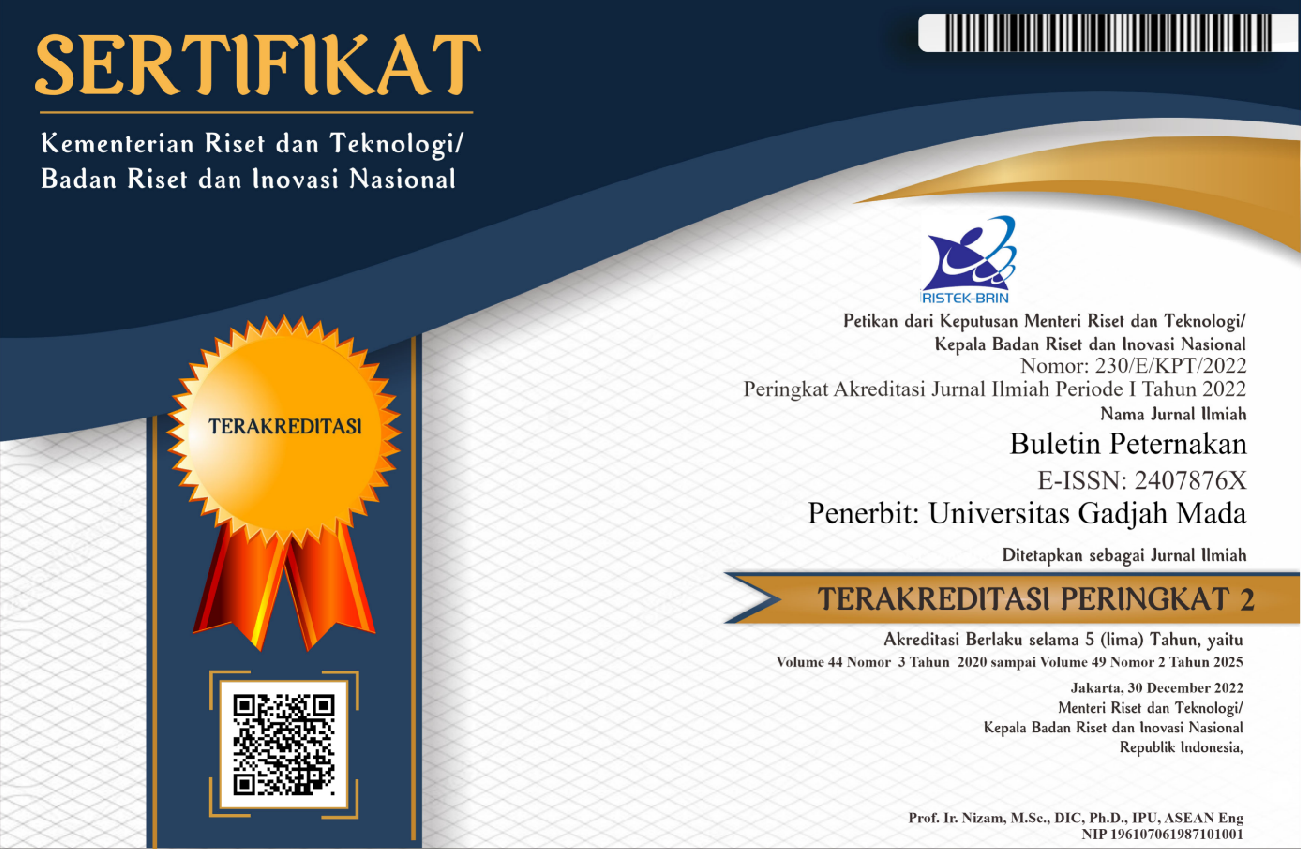Refeeding Postmolting Method to Improve Weekly Production Performance of Rejected Laying Hens with Low Mortality
Claude Mona Airin(1*), Amelia Hana(2), Pudji Astuti(3), Sarmin Sarmin(4), Trini Susmiati(5), Okti Herawati(6)
(1) Department of Physiology, Faculty of Veterinary Medicine, Universitas Gadjah Mada, Yogyakarta, 55283, Indonesia
(2) Department of Physiology, Faculty of Veterinary Medicine, Universitas Gadjah Mada, Yogyakarta, 55283, Indonesia
(3) Department of Physiology, Faculty of Veterinary Medicine, Universitas Gadjah Mada, Yogyakarta, 55283, Indonesia
(4) Department of Physiology, Faculty of Veterinary Medicine, Universitas Gadjah Mada, Yogyakarta, 55283, Indonesia
(5) Department of Biochemistry, Faculty of Veterinary Medicine, Universitas Gadjah Mada, Yogyakarta, 55283, Indonesia
(6) Department of Microbiology, Faculty of Veterinary Medicine, Universitas Gadjah Mada, Yogyakarta, 55283, Indonesia
(*) Corresponding Author
Abstract
Keywords
Full Text:
PDFReferences
Anonymous. 2018. Commercial management guide. https://www. hyline.com/userdocs/pages/BRN-COM.ENG.pdf. Accesed 7 Juli 2019.
Achmad, R., Y. Sukra, Barizi, and A. P. Sinurat. 2010. Hubungan antara penurunan bobot badan dan peningkatan produksi ayam petelur (dekalb warren) dalam program cekaman luruh bulu. Jurnal Veteriner 11: 58-63.
Bain, M. M., Y. Nys, and C. Dunn. 2016. Increasing persistency in lay and stabilising egg quality in longer laying cycles. what are the challenges?. British Poult. Sci. 57: 330-338.
Bar, A., V. Razaphkovsky, D. Shinder, and E. Vax E. 2003. Alternative procedures for molting induction: practical aspects. Poult. Sci. 82: 543-550.
Bovera, F., I. Francesco, P. Giovanni, D. Carmelo, R. Fabrizio, P. Daniela, A. A. Youssef, S. A. Saber, Hassan and N. Antonino. 2014. Effect of group size on performance and egg quality of laying hens during 20 to 36 weeks of age. Italian J. Anim. Sci. 13: 215 - 220
Bozkruatt, M., K. Küçükyilmaz, V. Ayhan, M. Çabuk and A. U. Çatli. 2011. Performance of layer or broiler breeder hens ovaries in response to different probiotic preparations. Italian J. Anim. Sci. 10: 162-169.
El-Sagheer, M., H. Y., El-Hammady, H. H. M., Hassanien, and H. A. Hassan. 2014. Effect of fasting period and feed form on post molt performance and egg quality in laying hens. J. Poult. Sci. 34: 619-634.
Farooq, M., M. A. Mian, F. R. Durrani and M. Syed. 2002. Feed consumption and efficiency of feed utilization by egg type layers for egg production. Livestock Research for Rural Development 14: 76-79.
Fitroh, M. N., M. A., Pagala, and H. Has. 2016. Pengaruh metode force molting yang berbeda terhadap rontok bulu ayam petelur afkir. J. Tropical Anim. Sci. Tech. 3: 87-92.
Fukuma, Y. and T. Ishibashi. 1997. Effect of crude protein level and refeeding method of postmolt diet on performance and egg quality in layers after forced molting. Jpn. Poult. Sci. 34: 255-262.
Gjorgosvska, N., K. Filev and R. Konakchieva. 2008. Influence of induce molting on hormonal status of aged laying hens. Karmiva. 50: 19-25.
John-Jaja, S. A. A., B. U. H. Udoh, and S. C. Nwokolo. 2016. Repeatability estimates of egg weight and eggshell weight under various production periods for bovan nera black laying chicken. Beni – Suef University Journal of Basic and Applied Sciences 5: 389-394.
Joyner, C. J., M. J. Peddie, and T. G. Taylor. 1987. The effect of age on egg production in the domestic hen. Gen. Comp. Endocrinol. 65: 331-336.
Kiptiyah, Hartanto, and Lisin. 2012. Pengaruh ranggas paksa dan suplementasi tepung bekicot terhadap pertumbuhan folikel yolk ayam (Gallus Turcicus). Sainstis 1: 43-54.
Mert. N. and B. A. Yildirim. 2016. Biochemical parameters and histopathological findings in the forced molt laying hens. Brazilian J. Poult. Sci. 18: 711-718.
Moustafa, G. Z., W. Anwer and E. M. Badawy. 2010. Effect of induced molting on performance of cobb broiler breeders under field condition. Arch. Geflügelk. 74: 87–93.
Mulyono, A. M. W., A. K. Sariri and W. T. Husodo. 2008. Penerapan teknologi force molting pada ayam petelur afkir: kajian parameter produksi, organ pencernaan dan reproduksi, pertahanan tubuh. Sains Peternakan 6: 10-17.
Nurcholis, D. Hastuti, and B. Sutiono. 2009. Tatalaksana pemeliharaan ayam ras petelur periode layer di populer farm desa kuncen kecamatan mijen kota semarang. Mediagro 5: 38-49.
Oguike, M. A., G. Igboeli, S. N. Ibe, S. M. Uzoukwu. C. Akomas and M. O. Ironkwe. 2005. Morphological characteristics and egg production of forced-moult layers under different moult induction techniques. African J. Biotech. 9: 1001-1004.
Rahman, A. I., O. P. Bonsu, and M. Yaro. 2012. Effect of forced moulting on performance of exotic hy-line brown layer birds under tropical climatic conditions. J. Anim. Sci. Adv. 5: 481-486.
Rath, P. K., P. K. Mishra, B. K. Mallick, and N. C. Behura. 2015. Evaluation of different egg quality traits and interpretation of their mode of inheritance in white leghorns. Veterinary World 8: 449-452.
Salang, F., L. Wahyudi, E. Queljoe, and D. Y. Katili. 2015. Kapasitas ovarium ayam petelur aktif. Jurnal Mipa Unsrat Online 4: 99-102.
Sharma, P. and G. Vishnu. 2013. Induced moulting in layers – A review. Agri. Reviews 34: 137-144.
Sundaresan, N. R., D. Anish, K. V. Sastry, V. K. Saxena, J. Mohan, and K. A. Ahmed. 2007. Cytokines in reproductive remodeling of molting White Leghorn hens. J. Reprod. Immunol. 73: 39-50.
Tumova, E., M. Englmaievova, Z. Ledvinda, and V. Charvatova. 2011. Interaction between housing system and genotype in relation internal and external egg quality parameters. Czech J. Anim. Sci. 56: 409-498.
Article Metrics
Refbacks
- There are currently no refbacks.

This work is licensed under a Creative Commons Attribution-ShareAlike 4.0 International License.
Buletin Peternakan (Bulletin of Animal Science) Indexed by:

This work is licensed under a Creative Commons Attribution-ShareAlike 4.0 International License.









